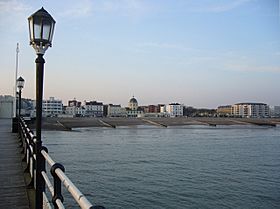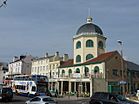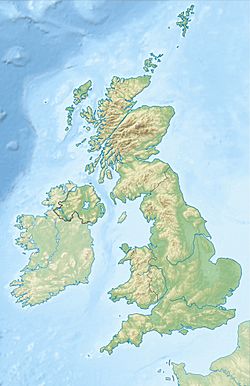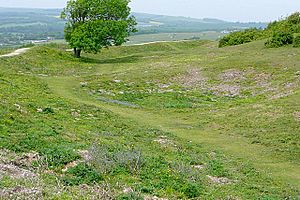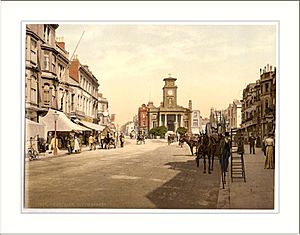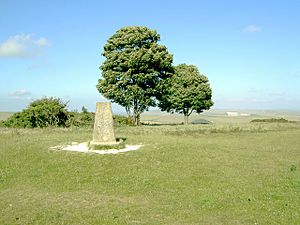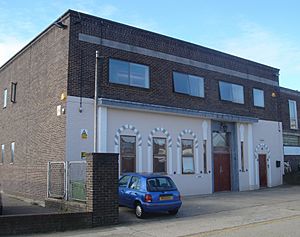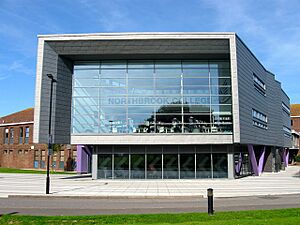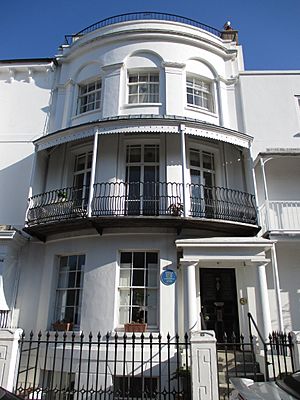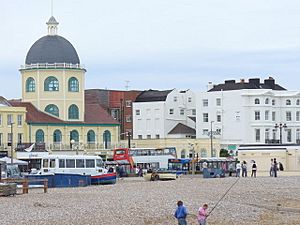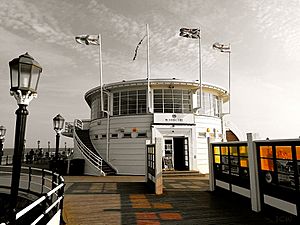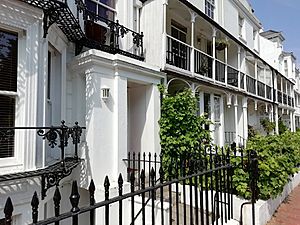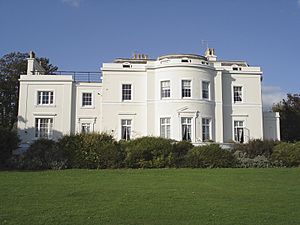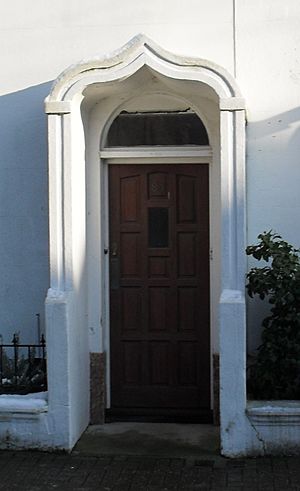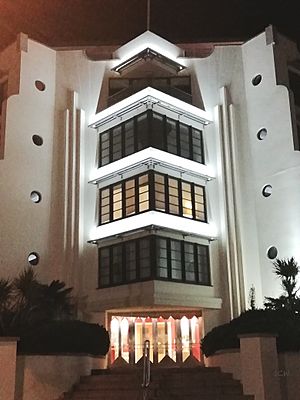Worthing facts for kids
Quick facts for kids
Worthing
Borough of Worthing
|
||
|---|---|---|
|
Clockwise, from top: Worthing seafront from Worthing Pier, Dome Cinema, Castle Goring, Cissbury Ring in the South Downs National Park, Connaught Theatre, Worthing Pier
|
||
|
||
| Etymology: Old English Wyrtingas | ||
| Nickname(s):
Sunny Worthing
|
||
| Motto(s):
"Ex terra copiam e mari salutem"
(Latin for "From the land plenty and from the sea health") |
||

Location within West Sussex
|
||
| Sovereign state | ||
| Country | ||
| Region | South East England | |
| Historic county | ||
| County | West Sussex | |
| Borough | Worthing | |
| Founded | In Antiquity | |
| Town charter | 1803 | |
| Borough status | 1890 | |
| Administrative HQ | Worthing Town Hall | |
| Government | ||
| • Type | Borough | |
| • Body | Worthing Borough Council | |
| Area | ||
| • Borough | 32.48 km2 (12.54 sq mi) | |
| Area rank | 307th | |
| Elevation | 7 m (25 ft) | |
| Highest elevation | 184 m (603 ft) | |
| Population
(2005 est.)
|
||
| • Borough | 110,570 (ranked 217th) | |
| • Urban | 474,485 | |
| Demonym(s) | Worthingite | |
| Ethnicity (2021) | ||
| • Ethnic groups |
List
|
|
| Religion (2021) | ||
| • Religion |
List
45.7% no religion
43.9% Christianity 6.3% not stated 1.7% Islam 0.7% other 0.7% Hinduism 0.6% Buddhism 0.2% Judaism 0.1% Sikhism |
|
| Time zone | GMT | |
| • Summer (DST) | British Summer Time | |
| Postcode |
BN11–BN14
|
|
| Area code(s) | 01903 | |
| ONS code | 45UH | |
| Highest point | Cissbury Ring (184m) | |
| Grid reference | SU775075 | |
Worthing (/ˈwɜːrðɪŋ/ WUR-dhing) is a lively seaside town in West Sussex, England. It sits at the bottom of the South Downs hills. The town is about 11 miles (18 km) west of Brighton and 18 miles (29 km) east of Chichester.
Worthing has a population of over 113,000 people. It covers an area of about 12.5 square miles (32.48 km²). This makes it the second largest part of the Brighton and Hove built-up area. The northern parts of Worthing are even part of the beautiful South Downs National Park. In 2019, the Art Deco Worthing Pier was named the best pier in Britain!
People have lived in the Worthing area for a very long time. Around 4000 BC, there were flint mines at Cissbury and other nearby hills. These are some of the oldest Stone Age sites in Britain. The large Iron Age hill fort called Cissbury Ring is also one of Britain's biggest. Worthing's recorded history began with the Domesday Book. For many centuries, it was a small village known for mackerel fishing.
In the late 1700s, Worthing grew into a fancy seaside resort. Rich and famous people started visiting. In the 1800s and 1900s, it became a major centre for growing vegetables. Today, Worthing has a big service industry, especially in money-related services. It has three theatres and one of Britain's oldest cinemas, the Dome. Famous writers like Oscar Wilde and Harold Pinter lived and worked here.
Contents
- Understanding the Name of Worthing
- A Look at Worthing's Past
- How Worthing is Governed
- Worthing's Location and Landscape
- Worthing's People
- Learning in Worthing
- Worthing's Economy and Future Plans
- Getting Around Worthing
- Public Services in Worthing
- Community and Volunteer Groups
- Worthing's Culture and Arts
- Worthing's Buildings and Design
- Folklore and Legends
- Parks and Green Spaces
- Annual Events in Worthing
- Media in Worthing
- Sports in Worthing
- Famous People from Worthing
- Twin Towns
- See also
Understanding the Name of Worthing
The name Worthing has a long history. The oldest known spelling is Wyrtingas from around 960 AD. In the Domesday Book, it was called Ordinges or Wordinges. Over time, the spelling changed many times. The modern name Worthing was first written down in 1297 AD.
The exact meaning of the name is not fully clear. One idea is that it comes from Wyrt, an Old English word for "plant" or "herb". Another idea is that it comes from Wyrd, the name of an Anglo-Saxon goddess.
The ending -ing often means "family," "people," or "followers of" in old English names. So, Worthing could mean "the people of Wyrt" or "the followers of Wyrd."
A Look at Worthing's Past
Worthing has a very old and interesting history.
Ancient Times: Flint Mines and Hill Forts
Around 4000 BC, the hills above Worthing were a huge area for mining flint. Flint was very important for making tools. Four of Britain's 14 known flint mines are close to Worthing. The oldest remains found in Worthing town centre are from the Bronze Age. There is also an important Bronze Age hill fort at Highdown Hill.
During the Iron Age, one of Britain's largest hill forts was built at Cissbury Ring. Later, the area was part of the Roman-British period. Some of Worthing's roads today follow the old Roman grid layout. A Roman-British farm used to be near where Worthing Town Hall is now. In the 400s and 500s, the area became part of the kingdom of Sussex. Many local place names, including Worthing itself, come from this time.
From Fishing Village to Seaside Resort
For many centuries, Worthing was a small village where people farmed and fished. But in the 1750s, rich visitors started coming. Princess Amelia stayed in Worthing in 1798. Soon, it became a popular place for fashionable and wealthy people. Worthing officially became a town in 1803.
The town grew quickly. Beautiful new areas like Park Crescent and Liverpool Terrace were built. In the 1800s, the area was known for smugglers. There were also riots in the 1880s involving a group called the Skeleton Army.
Famous Writers and World Events
Oscar Wilde spent holidays in Worthing in 1893 and 1894. He wrote his famous play The Importance of Being Earnest during his second visit. The town was also home to other writers in the 1900s, including Nobel prize-winner Harold Pinter.
On October 9, 1934, there were big fights in the town. These were between protestors and Oswald Mosley's British Union of Fascists. This event became known as the Battle of South Street. During World War II, many Allied soldiers stayed in Worthing. They were getting ready for the D-Day landings.
In 2009, Worthing became the 229th Transition Town in the world. This project helps the town plan for a future with less oil. It encourages local people to find new ways to live and work.
How Worthing is Governed
Worthing is run by two main local government bodies. These are Worthing Borough Council and West Sussex County Council. They work together to manage the town.
Local Council and Elections
Worthing Borough Council works with nearby councils as part of Adur and Worthing Councils. It is also part of the Greater Brighton City Region. The borough is divided into 13 areas called wards. Most wards elect three councillors, and two elect two councillors. This makes a total of 37 councillors.
In the 2022 election, the Labour Party took control of the council for the first time. Before that, the Conservatives had been in charge for 18 years.
County Council and Services
Worthing also elects nine councillors to the West Sussex County Council. This council is responsible for big services. These include school education, social care, and roads. The county council has been controlled by the Conservative Party since 1974.
Since 2014, Worthing has been part of the Greater Brighton City Region. The leader of Worthing Borough Council represents the town on the City Region's Economic Board.
Members of Parliament
Worthing has two Members of Parliament (MPs). These are Beccy Cooper (Labour) for Worthing West and Tom Rutland (Labour) for East Worthing and Shoreham. These MPs represent Worthing in the UK Parliament.
Worthing's Location and Landscape
Worthing is located in South East England, in West Sussex. It is about 49 miles (79 km) south of London. It is also about 10 miles (16 km) west of Brighton and Hove.
Hills and Green Spaces
North of the town are the chalk hills of the South Downs. These hills are part of a National Park. Some parts of Worthing, like High Salvington and Findon Valley, climb up the lower slopes of the Downs. The highest point in Worthing is Cissbury Ring, which is 603 feet (184 m) high.
Land at Cissbury Ring and the Worthing Downland Estate are open for everyone to visit. Other high points include West Hill (139m) and Highdown Hill (81m). Cissbury Ring is also a special area called a Site of Special Scientific Interest.
Town Size and Surroundings
Worthing is part of a larger urban area with about 200,000 people. This area stretches from Littlehampton to Lancing. Worthing is the second largest part of the Brighton and Hove built-up area. This is England's 12th largest group of towns, with over 470,000 people in 2011.
Worthing is bordered by other local areas. These are Arun to the north and west, and Adur to the east.
Geology and Water
Worthing is built on two types of rock. Most of the town, including the centre, is on chalk. A band of London clay runs west through Broadwater and Durrington.
The town is located between the Arun and Adur. The Teville Stream and Ferring Rife flow through the town. Part of the Ferring Rife starts in Titnore Wood. This is an important area of ancient woodland near the coast.
There are also "strategic gaps" at the edges of the town. These are areas of open land that stop the town from spreading too much. Worthing itself does not have any nature reserves. The closest one is Widewater Lagoon in Lancing.
Worthing's Underwater World
About 3 miles (5 km) off the coast of Worthing are the Worthing Lumps. These are underwater chalk cliffs, up to 10 feet (3 m) high. The Marine Conservation Society calls them "one of the best chalk reefs in Europe." They are home to rare fish like blennies and lesser spotted dogfish. This area is a Site of Nature Conservation Importance.
Since 2013, this area has also been part of the Kingmere Marine Conservation Zone. South of the shore, there used to be a huge kelp forest. This forest stretched from Bognor Regis to Brighton until the 1980s. Now, only a small part of it remains, and efforts are being made to help it grow back.
Worthing's Weather
Worthing has a mild ocean climate. Its average yearly temperature is 51.1°F (10.6°C). This is similar to other places along the Sussex coast. On most summer afternoons, a sea breeze blows from the south-west. This breeze is sometimes called The Worthing Effect by local watersports fans. It builds up during the morning and is strongest in the afternoon.
Worthing's Neighbourhoods
The names of Worthing's different areas show how the town grew. The central parts of the town used to be two separate areas: Worthing and West Worthing. They joined together in 1890 when Worthing became a borough. This area includes the town centre, East Worthing, and West Worthing.
To the north and west are older villages that became part of the town in the 1900s. These include Broadwater, Durrington, Goring, and (West) Tarring. Findon Valley was once part of the village of Findon. Other areas within these parishes are High Salvington, Offington, and Salvington.
Worthing's People
Let's look at how Worthing's population has changed and who lives there today.
Population Growth Over Time
Worthing's population was estimated to be 110,570 in 2019. It is the second most crowded area in East and West Sussex. In 2011, there were about 33.83 people per hectare.
Worthing's population grew a lot in the early 1800s when it became a town. It grew again in the 1880s. More growth happened in the 1930s. New housing estates were built after 1948, some using prisoner of war labour.
In recent years, many people have moved to Worthing. It is a popular place for people moving from nearby Brighton and Hove. Many people also move to Worthing from London.
| Year | Population | Year | Population | |||
|---|---|---|---|---|---|---|
| 1801 | 2,151 |
|
1921 | 37,906 |
|
|
| 1811 | 3,824 |
|
1931 | 45,905 |
|
|
| 1821 | 4,922 |
|
1939 | 55,584 |
|
|
| 1831 | 5,654 |
|
1951 | 67,305 |
|
|
| 1841 | 6,856 |
|
1961 | 77,155 |
|
|
| 1851 | 7,615 |
|
1971 | 88,467 |
|
|
| 1861 | 9,744 |
|
1981 | 90,686 |
|
|
| 1871 | 11,873 |
|
1991 | 98,066 |
|
|
| 1881 | 14,002 |
|
2001 | 97,540 |
|
|
| 1891 | 19,177 |
|
2011 | 104,640 |
|
|
| 1901 | 24,479 |
|
2021 | 111,400 |
|
|
| 1911 | 31,301 |
|
2031 | 122,200 |
|
|
Source: A Vision of Britain Through Time, Office for National Statistics ONS population projections 2014 base / projections uplifted by '21-1,800/'26-2,100/'36-2,500 given underestimation at 2016 - 2,250/
Different Backgrounds
The 2021 census showed that 91.2% of Worthing's population was White. About 2.5% were of mixed ancestry. Around 4.0% were Asian, and 1.2% were Black. There were also smaller groups of Arab and other ethnic backgrounds.
Worthing also has communities from other countries. In 2021, about 0.79% of people were born in Poland. About 0.70% were born in India, and 0.68% in the Philippines. Around 0.65% were born in Romania.
Age Groups
Worthing has a younger population compared to other coastal areas in West Sussex. However, it is still older than the average for the South East of England. In 2006, about 26.7% of people were between 25 and 44 years old.
Over the last 20 years, the number of people aged 65 or more has decreased in Worthing. At the same time, the number of older families and young adults starting families has increased. In 2010, the average age in Worthing was 42.8 years. This is a bit older than the UK average of 39.6 years.
Religious Beliefs

In Worthing, more people identify as Christian than any other religion (43.9% in 2021). There are about 50 active Christian churches in the borough. The local Churches Together group helps churches work together.
Worthing's first Anglican church, St Paul's, was built in 1812. Before that, people had to go to the older church in Broadwater. As Worthing grew, more Anglican churches opened. Some ancient villages that became part of Worthing also had their own old churches. All of Worthing's Anglican churches are part of the Diocese of Chichester.
The first Roman Catholic church in Worthing opened in 1864. Now there are others in East Worthing, Goring-by-Sea, and High Salvington. These are all part of the Roman Catholic Diocese of Arundel and Brighton.
Other Christian groups have a long history in Worthing too. These include Methodists, Baptists, the United Reformed Church, and Evangelical Christian groups. The Salvation Army has been in Worthing for over 100 years. Their arrival in the 1880s led to large riots with a group called the Skeleton Army.
In 2021, 1.7% of Worthing's population was Muslim. Since 1994, the Muslim community has had a mosque called Worthing Masjid or Masjid Assalam. This mosque follows the Sunni tradition.
There are also small communities of Buddhists (0.6% in 2021) and a small Jewish community (0.2% in 2021). In 2011, some people were Hindu (0.7%), Sikh (0.1%), or followed other religions (0.7%). A small group of the Baháʼí Faith also meets in Worthing.
A large number of people (45.7%) said they had no religion in 2021. This is higher than the average for England and Wales.
Learning in Worthing
Worthing has many schools and colleges for students of all ages.
There are 22 primary schools and six secondary schools. There is also one special school for both primary and secondary students. Worthing has two private schools, one sixth form college, and one college for higher and further education.
Northbrook College started in 1890 as the Worthing School of Art and Science. Its main campus is in West Durrington. Here, students can study creative arts degrees. Northbrook and Worthing College (a sixth form college) are both part of the Chichester College Group.
West Sussex County Council runs six state secondary schools. These include Bohunt School Worthing, Durrington High School, St Andrews High School, and Worthing High School. Davison High School is a girls' school. St Oscar Romero Catholic School is a Catholic school. Our Lady of Sion School is a private school for children aged 3–18.
Worthing's Economy and Future Plans
Worthing's economy mainly relies on the service industry. This is especially true for financial services.
Key Industries and Jobs
| Labour Profile | ||
|---|---|---|
| Total employee jobs | 43,800 | |
| Full-time | 28,000 | 63.9% |
| Part-time | 15,800 | 36.1% |
| Manufacturing | 3,300 | 7.5% |
| Construction | 1,100 | 2.4% |
| Services | 38,900 | 88.7% |
| Distribution, hotels & restaurants | 9,600 | 22.0% |
| Transport & communications | 1,400 | 3.3% |
| Finance, IT, other business activities | 9,600 | 22.0% |
| Public admin, education & health | 16,200 | 36.9% |
| Other services | 2,000 | 4.6% |
| Tourism-related | 3,000 | 7.0% |
Big employers in Worthing include GSK, LEMO electronics, Rayner Lenses, and HM Revenue & Customs. The Environment Agency and Southern Water also employ many people. In 2009, there were about 43,000 jobs in Worthing.
In 2009, GlaxoSmithKline announced that 250 jobs would be lost at its Worthing factory. This factory makes important antibiotics.
Worthing was named the most profitable town in Britain for three years in the late 1990s. However, in 2009, the average pay for Worthing residents was lower than for West Sussex and South East England.
In 2008, Worthing was among the top 10 urban areas in England for jobs in creative, high-tech, and knowledge-based industries. A 2012 study ranked Worthing as the second best town in the UK for internet and transport connections. It was ranked fifth overall out of 74 towns and cities.
Plans for the Future
In 2006, Worthing Borough Council approved a plan to improve the town. This plan focuses on the town centre and seafront. A new £150 million project is planned for Teville Gate. This area is near Worthing railway station. It is expected to include homes, a cinema, a hotel, and a conference centre.
There are also plans to redevelop the Grafton Street car park area. The Guildbourne Centre, a large shopping centre, might be rebuilt and made bigger.
In the long term, the area around Worthing's museum, art gallery, library, and town hall will be updated. This "Worthing Cultural and Civic Hub" will get new facilities and housing. In 2009, the council asked for a £5 million grant to improve the museum.
A new £16 million swimming pool, Splash Point Leisure Centre, opened in 2013. It was designed by famous architects. It has also been suggested that Montague Place become a pedestrian-only area. This would make it easier to walk between the town centre and the seafront.
Some projects have already been finished. The Dome Cinema reopened in 2007 after big investments. A £5.5 million development was completed on the site of an old hotel near Teville Gate.
Getting Around Worthing
Worthing has good transport links, both locally and to other parts of the UK.
Roads and Buses
A toll road was opened in 1803 to connect Worthing with London. Other toll roads were built later to connect nearby villages. These roads were very busy until 1845. That's when a railway line from Brighton opened, and stagecoach travel quickly declined.
The old toll road is now the A24. This main road goes north to London and connects Worthing to the M25 motorway. Two other main roads run through Worthing. The A27 goes east to Brighton and west to Chichester and Portsmouth. The A259 follows the coast between Hampshire and Kent.
Most local and long-distance buses are run by Stagecoach South. This company started in 1915. Stagecoach runs many routes around Worthing and to other towns. The most frequent service, between Lancing and Durrington, is called PULSE. Other bus companies also serve Worthing. National Express coaches run services between London and Worthing. In the 1920s and 1930s, special "Worthing Tramocars" also ran local bus services.
Trains and Airports
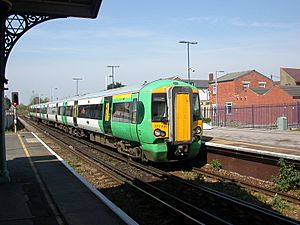
Worthing has five railway stations: East Worthing, Worthing, West Worthing, Durrington-on-Sea, and Goring-by-Sea. All are on the West Coastway Line. They are managed by Govia Thameslink Railway.
Worthing station opened in 1845 as a temporary end point for the line from Brighton. The line was extended to Chichester the next year. It was made electric in the 1930s. Regular trains run to places like London, Gatwick Airport, Brighton, and Portsmouth.
Shoreham Airport is about 5 miles (8 km) east of Worthing. The closest major international airport is Gatwick, which is about 28 miles (45 km) northeast.
Public Services in Worthing
Worthing has many important public services to keep its residents safe and healthy.
Police and Fire Services
The police in Worthing are part of Sussex Police. The town is divided into two policing areas: North and South. The police station is on Chatsworth Road. The main office for the West Downs division is at Centenary House in Durrington.
Worthing's fire station has been in Broadwater since 1962. Before that, volunteers provided fire services. The Worthing and Adur District Team has 60 full-time and 18 part-time firefighters.
Healthcare
Worthing Hospital is run by the University Hospitals Sussex NHS Foundation Trust. This hospital has 500 beds. It started in 1881 as a small infirmary with 18 beds. It replaced older hospitals in Ann Street and Chapel Road.
Other healthcare places include two mental health units. There is also a private hospital in the historic Goring Hall.
Utilities
Gas was made in Worthing for almost 100 years until 1931. Now, Scotia Gas Networks supplies gas to the town. Electricity was generated locally between 1901 and 1961. Today, EDF Energy supplies electricity.
Southern Water has managed Worthing's water supply and sewage since 1974. Their main office has been in Durrington since 1989. The town's first waterworks was built in 1852. In the 1800s, sewage systems were not very good. A deadly typhoid outbreak in 1893 led to big improvements in sewage works and pipes.
Community and Volunteer Groups
Worthing has many groups that help the community. These range from small volunteer groups to large charities. There is a Council for Voluntary Service and a Volunteer Centre. These are funded by the local council to support volunteer work.
In 2003-2004, charities in Worthing reported a total income of £56 million. A survey in 2009 found that up to 24,000 people in Worthing said they volunteered their time in the community.
Worthing's Culture and Arts
Worthing has a rich cultural scene, including famous writers, films, music, and theatres.
Literary Connections
John Selden, a famous philosopher, was born in Salvington, Worthing, in 1584. Jane Austen's last unfinished novel, Sanditon, is thought to be based on her time in Worthing in 1805. Some of Percy Bysshe Shelley's first works were printed in Worthing. His grandfather built Castle Goring.
Oscar Wilde wrote The Importance of Being Earnest while staying in Worthing in 1894. He even named the main character, Jack/Ernest Worthing, after the town. In the 1960s, playwright Harold Pinter wrote The Homecoming at his home in Ambrose Place. Other writers who lived in Worthing include Stephen Spender and Dorothy Richardson.
Film and TV in Worthing
Film history in Worthing goes back to 1896. That's when films were first shown on Worthing Pier. In 1898, William Kennedy Dickson, who invented an early movie device, filmed daily life in the town. Many cinemas opened in the early 1900s.
The Kursaal was built in 1910 as a skating rink and theatre. It was renamed the Dome in 1915 during World War I. The Dome Cinema opened in 1922 and is still open today. It is one of Britain's oldest working cinemas. The Connaught Screen 2 cinema opened in 1995.
Many films and TV shows have been filmed in Worthing. These include Pinter's The Birthday Party (1968) and Black Mirror (2023). Other films like Dance with a Stranger (1985) and Stan & Ollie (2018) also used Worthing as a setting. The TV series Cuffs (2015) was also filmed here.
Music Scene
Worthing has been home to many musicians. These include Alma Cogan, Royal Blood, and The Ordinary Boys. In the late 1960s, the Worthing Workshop was a group of artists and musicians. This group included Leo Sayer and Brian James of The Damned.
In 1970, a field near Worthing hosted the Phun City music festival. This was the UK's first large free music festival. In the late 1980s and early 1990s, Sterns Nightclub was a big centre for rave music. Worthing still has a lively electronic music scene.
Music venues in Worthing include the Assembly Hall and the Pavilion Theatre. The Assembly Hall is home to the Worthing Symphony Orchestra. Howarth of London, a company that makes professional oboes, is based in Worthing.
Theatre Performances
As of 2019, Worthing has three theatres owned by the council. These are the Art Deco Connaught Theatre, the Baroque Pavilion Theatre, and the Modernist Assembly Hall. The Assembly Hall is mostly used for music.
Theatre has been performed in Worthing since 1796. The town's first permanent theatre, the Theatre Royal, opened in 1807. It operated until 1855.
Museums and Art
Worthing Museum and Art Gallery has one of the most important costume collections in the UK. It was built in 1908 as the town's museum and library. It is expected to be redeveloped in 2020.
In art, painter Copley Fielding lived in Worthing in the mid-1700s. More recently, Jamie Hewlett and Alan Martin created the famous comic character Tank Girl while at college in Worthing. The town also has a famous sculpture by Elisabeth Frink called Desert Quartet (1990).
English Martyrs' Catholic Church in Goring has a unique feature. It has the world's only known copy of Michelangelo's Sistine Chapel ceiling, painted by Gary Bevans.
Worthing's Buildings and Design
Worthing has a mix of old and new buildings, showing its long history.
Historic Architecture
Few buildings in central Worthing are older than the 1800s. These are mostly a few buildings on Worthing High Street from when it was a small fishing village. However, there are older buildings in the former villages outside the town centre. For example, parts of St Mary's Church in Broadwater date back to the Saxon period. West Tarring has several buildings from the medieval and Tudor times, like St Andrew's Church and the Archbishop's Palace, which are from the 1200s.
Worthing has 213 listed buildings. Three of these are Grade I listed, meaning they are "of exceptional interest." These are Castle Goring, St Mary's Church at Broadwater, and the Archbishop's Palace at West Tarring. Worthing Pier, Park Crescent, Beach House, and several churches are also listed.
Sadly, many historic buildings have been lost since 1896. The town's first theatre, the Theatre Royal, was demolished in 1970. Other old buildings like Warne's Hotel and early bath-houses have also been lost.
Building Materials and Unique Features
Pale yellow bricks have been made locally since about 1780. They are often used in buildings in Worthing. Flint is another common building material because it is found in the area. Buildings often combine flint with red brick, especially in the late 1800s and early 1900s.
Boat porches are a unique architectural feature found only in Worthing. These are porches around entrance doors of some early 1800s houses. They have a curved roof that looks like the bottom of a boat. Some people think local fishermen built these cottages and used their boats as a design idea.
Worthing has a few tall residential buildings. Manor Lea, built in 1967, is 141 feet (43 m) tall. Bayside Vista, which is being built, will be 172 feet (52 m) tall. The Splashpoint Leisure Centre won an award for its design in 2013. A 151-foot (46 m) tall ferris wheel opened in 2019.
Folklore and Legends
Worthing has some interesting old stories and legends.
The Midsummer Tree
The Midsummer Tree is a large oak tree near Broadwater Green. It is thought to be about 300 years old. Until the 1800s, people believed that on Midsummer's Eve, skeletons would rise from the tree. They would dance around it until morning, then sink back into the ground. This legend was first written down in 1868. Since 2006, people have gathered at the tree on Midsummer's Eve.
Knuckers and Tunnels
It was once believed that monsters called knuckers lived in very deep ponds called knuckerholes. There were several knuckerholes in Sussex, including one in Worthing. This one was near Ham Bridge, close to East Worthing railway station.
Another legend says there was a tunnel several miles long. It supposedly led from the old Offington Hall to the ancient flint mines at Cissbury. The tunnel was said to be sealed, and there was treasure at the end. The owner of the Hall offered money to anyone who would clear the tunnel. But people were scared away by large snakes that would spring out at them.
Parks and Green Spaces
Worthing offers many beautiful outdoor areas for everyone to enjoy.
Beaches and Hills
The town has 5 miles (8 km) of beach along the coast. To the north, there are large open spaces on the South Downs. These include the Worthing Downland Estate, Cissbury Ring, and Highdown Hill. These areas are great for walking and enjoying nature.
Town Parks and Gardens
Worthing also has many parks and gardens within the town. Many of these were created in the Victorian and Edwardian eras.
- Beach House Green
- Beach House Park – This park is famous for bowls, a sport played on a lawn. It is one of the best bowls venues in the world. The park also has a unique memorial to homing pigeons that served in the Second World War.
- Broadwater Green – This is the 'village green' for Broadwater.
- Brooklands Park
- Denton Gardens – At the south end, there is an 18-hole Crazy Golf course.
- Field Place – This area has tennis courts, lawn bowls, and putting.
- Goring Green
- Highdown Gardens – A special garden at the foot of the South Downs. It has a collection of rare plants from East Asia.
- Homefield Park – Once known as the 'People's Park'. It has a concrete skatepark and tennis courts.
- Liverpool Gardens – These gardens overlook the elegant Georgian Liverpool Terrace. The gardens feature four bronze heads called Desert Quartet, sculpted by Dame Elisabeth Frink.
- Marine Gardens
- Tarring Park
- Palatine Park
- Promenade Waterwise Garden
- Steyne Gardens – This garden has a fountain of the Ancient Greek sea god, Triton.
- Victoria Park – This park was given to the people of Worthing to remember Queen Victoria. It used to be a market garden. Today, it is used by sports clubs and casual footballers.
- West Park – This park has a running track and basketball court. It is next to Worthing Leisure Centre.
Annual Events in Worthing
Worthing hosts many exciting events throughout the year.
The Worthing Festival is a multi-arts festival that happens in June. It features various arts and crafts events across the town. Worthing Artists' Open Houses is an annual festival where artists open their homes to show their work. In the last two weeks of July, open-air concerts take place in the town centre. There is also a fairground along the promenade. Worthing Pride has been celebrated in the town since 2018. From 2008 to 2015, Worthing was home to the International Birdman competition.
In January, the old custom of wassailing takes place in Tarring. This is done to bless the apple trees. A torchlit procession goes down Tarring High Street. Hundreds of people gather around an apple tree to shout, chant, and sing to scare away bad spirits. The apple trees are toasted with special drinks and apple cake, followed by fireworks. On May Day, a procession and dancing happen in Worthing town centre. This ends with the crowning of the May Queen.
Media in Worthing
Worthing has its own local newspapers, radio stations, and is covered by regional TV.
Newspapers
In the early 1800s, Worthing was served by newspapers from wider areas like Brighton. Local publications started appearing in the mid-1800s. The town's first regular local newspaper was the Worthing Gazette, started in 1883.
The Worthing Herald was founded in 1920. It bought the Gazette in 1963. Since 1981, a single newspaper has been published weekly under the Herald name. It is now owned by Johnston Press. The daily newspaper The Argus, based in Brighton, also covers Worthing.
Radio and TV
More Radio Worthing is Worthing's local commercial radio station. It started in 2003 and broadcasts on 107.7FM. Heart South, another commercial station, also covers Worthing. BBC Local Radio coverage is provided by BBC Radio Sussex.
Worthing is served by BBC South television from Southampton and BBC South East from Tunbridge Wells. It also receives TV from the ITV channel Meridian Broadcasting.
Sports in Worthing
Worthing offers many sports activities, especially water sports.
Water Sports and Outdoor Activities
Worthing's 5 miles (8 km) of coastline are great for water sports. These include catamaran racing, windsurfing, and kitesurfing. The town has held a regatta for rowing since at least 1859.
The South Downs are popular for hiking and mountain-biking. Worthing has two golf clubs on the Downs. The Three Forts Marathon is a 27-mile (43 km) ultramarathon. It goes from Broadwater to three Iron Age hill forts.
Team Sports
Worthing F.C., nicknamed "The Rebels" or "The Mackerel Men", is the town's main football club. It was formed in 1886. The men's team plays in the National League South. The women's team plays in the FA Women's National League South East. Worthing United F.C. are nicknamed the "Mavericks".
Worthing Rugby Football Club is nicknamed Worthing Raiders. They play in National League 2 East. They have been based in Angmering since 1977. Worthing Thunder was formed in 1999 and plays basketball in the National Basketball League. The Worthing Bears (now closed) won the British Basketball League in 1992–93. Worthing Hockey Club was formed in 1896.
The promenade is used for the Worthing parkrun. This is a free, weekly 5 km run that started in June 2016.
Bowls Championships
Worthing is one of only three places in the world to have hosted the men's World Bowls Championship twice. These events were held in 1972 and 1992 at Beach House Park. This park is sometimes called the spiritual home of bowls. It also hosts the annual National Championships every August. Beach House Park also hosted the Women's World Bowls Championship in 1977.
| Club | Nickname | Sport | League | Venue | Established |
|---|---|---|---|---|---|
| Worthing Cricket Club | Cricket | Sussex Premier League | Manor Sports Ground | 1855 | |
| Worthing Football Club | The Rebels | Football | National League South | Woodside Road | 1886 |
| Worthing Rugby Football Club | Raiders | Rugby union | National League 2 East | Roundstone Lane, Angmering | 1920 |
| Worthing United Football Club | The Mavericks | Football | Southern Combination Football League | Robert Albon Memorial Ground | 1988 |
| Worthing Thunder | Thunder | Basketball | English Basketball League | Worthing Leisure Centre | 1999 |
| Worthing F.C. Women | The Rebels or the Reds | Football | FA Women's National League South East | Woodside Road |
Famous People from Worthing
Many notable people have connections to Worthing.
- Luke Nelson, a basketball player, grew up in Worthing. He first played for the Worthing Thunder youth teams.
- Jane Austen, the famous author, lived in Worthing in 1805. Her unfinished novel Sanditon is set in a resort like early Worthing.
- Mary Shelley, who wrote Frankenstein, inherited Castle Goring in 1845.
- Oscar Wilde, the author, wrote The Importance of Being Earnest in Worthing in 1894. He named the main character, Jack Worthing, after the town.
- Liz Smith, an actress known for 'The Vicar of Dibley' and 'The Royle Family'.
- Henty brothers, pioneer farmers in Australia, including Edward Henty, were born in West Tarring in 1810.
- James Bateman, a horticulturalist.
- Thomas Shaw Brandreth, a mathematician and inventor.
- Copley Fielding, an artist.
- Gwendoline Christie, an actress and model.
- Nicollette Sheridan, an actress from Desperate Housewives, was born here.
- DJ Fresh, a musician, was born in Worthing.
- Christopher Hewett, an actor from Mr. Belvedere.
- William Henry Hudson, a writer and naturalist.
- Billy Idol, a musician, was born in Worthing.
- Mike Kerr, the singer and bassist of Royal Blood, grew up in the town.
- Keith Emerson, a musician, lived and went to school in Worthing.
- Peter Bonetti, an England goalkeeper.
- Byron Dafoe, a National Hockey League goaltender.
- Patrick Hadley, an English composer.
- Kenny Tutt, an English chef who won MasterChef 2018.
- Laurence Olivier, a famous actor, was born nearby in Dorking in 1908.
- Anthony A. Barrett, a classical scholar and author.
In the 1900s, these writers chose to live in Worthing:
- Beatrice Hastings, a poet.
- Harold Pinter, a playwright.
Twin Towns
Worthing is twinned with two areas:
- Four small towns in the Eltztal region of Germany: Waldkirch, Elzach, Gutach im Breisgau, and Simonswald. This partnership started in 1997.
- The Pays des Olonnes in France, which includes the seaside town of Les Sables-d'Olonne. This partnership started in 1998.
 |
Clapham Patching |
Buncton | Steyning |  |
| Littlehampton | Shoreham by Sea | |||
| Normandy | Normandy | Picardy |
See also
 In Spanish: Worthing para niños
In Spanish: Worthing para niños


